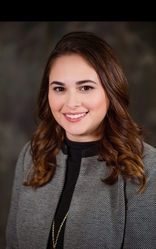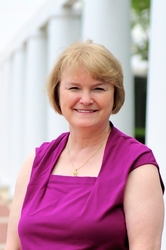In late 2018, Roberta Azzo, an operations program manager at Bon Secours St. Francis Medical Center in Midlothian, Virginia, decided to take an all-hands-on-deck approach to infusing the hospital’s culture with a trauma-informed approach to care. This involves recognizing that trauma is widespread and that it can cause all kinds of troubled behavior, learning ways to de-escalate that behavior, and preventing practices that trigger patients and staff who have experienced trauma.
The hospital began by creating a task force with representatives of many different departments: intensive care, risk management, the medical/surgical unit, the emergency room, security, food and nutrition, IT, and environmental services. Together they would figure out how to move forward on a trauma-informed approach.

Azzo’s interest in trauma-informed care grew out of conversations she had with the nursing leadership and with patient-experience experts in the Bon Secours ministry. “I learned more about how the non-tangible aspects of care delivery can influence a patient’s experience,” she said.
With the blessings of the hospital CEO and other decision makers, Azzo moved ahead. At the first meeting with representatives from each department in October 2018, they started asking questions like, “How do we roll this out? How do we actually ingrain this into our culture so that it's not just a flavor-of-the-month type thing?”
Such an effort was already underway in Bon Secours St. Mary’s hospital and Children’s Hospital of Richmond, Virginia, part of VCU Health systems, which were both introducing trauma-informed practices into their pediatric units. (See this story about St. Mary’s.) But Azzo and others there were convinced that these concepts could translate to adult patients as well. “[An adult] doesn’t just get over their childhood trauma,” Azzo said. “It follows them.”
The team laid out a three-phase trauma-informed care plan: build awareness among the leadership about what trauma-informed care is; develop skills to recognize how people react to stressful situations, provide tips to calm behaviors triggered by stress; and ensure that trauma-informed practices filter through every layer of the hospital.
Before team members progressed to the next part of their plan, they wanted to understand what, if anything, hospital personnel knew about traumatic stress and trauma-informed practices. They developed a survey to find out, which was a good move, because of the 79 people who responded, almost none had any idea. “They thought trauma was [physical] trauma,” says Azzo.
Around 19 percent didn’t even know what traumatic stress is, and more than 25 percent didn’t know how traumatic stress affects the brain and the body. In response to the statement: “Topics related to trauma stress are addressed in team meetings,” more than 54 percent strongly disagreed, an indication that, indeed, awareness about traumatic stress and trauma-informed practices was not embedded into the culture.
Azzo and her peers didn’t have to look far to figure out how to boost awareness about trauma-informed care. The building blocks of that had already been established by the Greater Richmond Trauma-Informed Community Network. Through that connection, the St. Francis Trauma-Informed leadership team learned about the film “Resilience: The Biology of Stress and the Science of Hope.”
The film explores ACEs science. The term ACEs comes from the landmark Centers for Disease Control and Prevention/ Kaiser Permanente Adverse Childhood Experiences study of more than 17,000 adults, which linked 10 types of childhood trauma to the adult onset of many chronic diseases, mental illness, violence and being a victim of violence. The study found that ACEs are remarkably common — most people have at least one. People who have four or more different types of ACEs — about 12 percent of the population — have a 1,200 percent higher risk of attempting suicide and a 700 percent higher risk of becoming an alcoholic, compared with people who have no ACEs.
The epidemiology of childhood adversity is one of five parts of ACEs science, which also includes how toxic stress from ACEs affects children’s brains, the short- and long-term health effects of toxic stress, how toxic stress is passed on from generation to generation, and research on resilience, which includes how individuals, organizations, systems and communities can integrate ACEs science to solve our most intractable problems.
The trauma-informed leadership team also brainstormed about practices they had observed that needed to be changed, practices that reflected a blaming or shaming mindset, which Azzo says is not unique to their hospital. “Some patients were labeled frequent flyers or drug-seeking without understanding what happened to the person.” That same focused inquiry, they understood, should guide how they respond to patients who are uncooperative or violent.
The film gave Azzo and her team just what they needed. Together they set a goal of showing it to their entire executive team, both clinical and non-clinical leadership—80 people in all—by the end of 2019. With one or two screenings monthly, they met that goal.
After screening the film, they would initiate conversations about how a history of childhood trauma can easily push someone into a threat response of “fight, flight or freeze.” And recognizing that the film could trigger the viewers, they were prepared: “Because [we know that] engaging the senses is the best way to help ground someone, we had mints, we had little fidget toys, things like that—just something to help our teams cope with what they were going to go through while watching the film and engaging in the post-film discussion.”
During those discussions, which were facilitated by a team of social workers, people revealed how they were affected by the film. “Our teams opened up about personal situations they’d been through and how those may be affecting the care that they provide,” Azzo said. The social workers said that people might get triggered by the film and should feel free to take a break, which some did. “People get emotional during the film. Some needed to step out of the room and take a breath.”
From the end of 2018 through 2019 they held a dozen trainings on the basics of a trauma-informed approach, open to any of the 120 people who had seen the “Resilience” film.

A group of nurses led by the Chief Nursing Officer Barb Gesme and the Clinical Director of Women’s and Children’s Services Beth Lavely also developed a program to build empathy, in response to findings from a recent survey of patient satisfaction. Comments included: “I don’t feel like people are listening to me,” and, “I don’t feel heard, nurses were just in and out [of the room].” Those impressions also jibed with what Gesme and other nurse leaders were hearing from nurses themselves, who were diligently caring for their patients, but feeling that they often didn’t have a chance to connect with them.
Gesme used the book See Me as a Person: Creating therapeutic relationships with patients and families as a framework for her training, which involved using various prompts. For example, she would ask a question like, “How does it feel to sit in a bedpan for 15 minutes before somebody comes to help you?” She also worked to identify empathy champions not just in nursing but all across the hospital. “I don’t care what you’re doing in the hospital, in whatever role you’re in, you’re contributing to taking care of the patient,” said Gesme.
Another part of the empathy training covered the idea of active listening. Beth Lavely, along with two other nurses, Jen Stanley and Melissa Burgio. asked each leader in all 36 departments of the hospital to identify an empathy champion, who would attend the training. There they were taught skills in active listening and role playing, ways to calm patients who are triggered, and ways to make personal connections with patients. The training ended in late October, and already they are deploying some of the strategies on the floors, including something called an empathy huddle. At the end of each week, various teams across the hospital gather and ask things like, “How’s everybody doing? What do we need to do for each other? How can we better listen? How can we better support?”
As part of the project, the empathy champions relay experiences they’ve witnessed on the floor that show their work being put into practice. Those experiences are becoming part of a shared repository of empathy stories. Gesme relays a recent example from an employee who was transporting a patient for a test. “The patient was near tears and [the transporter] stopped and asked, ‘What’s the matter?’” The patient didn’t understand what the test was about. “So [the transporter] sat down face-to face with the patient and explained everything about the test. Then the patient was OK.”
Another nurse was asking a patient questions in preparation for surgery, and the patient said in barely a whisper that he was really afraid. “And the nurse stopped and asked him if he would like her to pray with him, and he said yes. So she grabbed his hand and they prayed together,” says Gesme.
Such gestures, says Azzo, fuel trust so that patients can open up to their health care providers in new ways. “If there’s a particular trauma, [a patient has] gone through and for some reason it feels safer to have a female rather than a male nurse, they may be more willing to share that.”
Laying the groundwork for trust through the empathy program, the hospital is hoping to see a shift in incidents of patients becoming agitated . “If we identify any red flags and trigger points for patients, we can reduce the number of violent workplace events we’re seeing,” explains Gesme.
A separate committee worked on posters to put around the hospital to help prevent such incidents.They brought the visuals to the trauma-informed task force, which steered them in an entirely different direction on how they were messaging. “We had some concerns about the verbiage. We thought it was confrontational,” says Azzo, who says the poster told patients who were angry to calm down. “”If someone’s angry with you, telling them to calm down is not going to help. It’s going to have the opposite effect.”
Consciously attending to the hospital environment so it buffers stress and makes people feel safer has been particularly important during the COVID-19 pandemic, when high-intensity emotions are running rampant. “Some of our patients were dying alone, and those who weren’t dying weren’t allowed to have visitors. So our nursing team had to step up and become the family for our patients, taking on the emotional burden of that. We were seeing patients die who typically wouldn’t die under non-COVID circumstances,” Azzo said.
Their critical care nurses were not prepared for this, but they were also brushing off offers of help. “That’s just the culture of nursing,” said Azzo. “You endure it and you get over it.”
But they weren’t getting over it.
“We saw some of our strongest nurses just crumble under the pressure,” said Azzo, so she and the team jumped into action. They started putting together a mindfulness corner on their COVID command unit. Then that morphed into an entire room, which they dubbed the “Zen Den.”
They dimmed the lights and put in plants, soothing music, and a video of a peaceful landscape. They also provide biblical verses, a variety of snacks and even some things to play with, like Play-Doh and coloring books, and cards to write motivational messages for colleagues. And since people are wearing masks all day, they wanted something to make them feel fresh when they go home. “So we bought some oral hygiene products and Chapstick, just something to help people feel like themselves again.”
In addition to being a momentary respite, the idea is that the room will also help prevent burnout in the staff, a problem that has only intensified nationally during the COVID-19 pandemic. Recent commentary in the Cleveland Clinic Journal of Medicine, for example, noted that burnout among health care workers already exceeded 40 %. A survey of 9,500 critical care providers revealed that self reported stress had more than doubled during COVID "from a [median] score of 3 to a score of 8.3."
At a recent meeting, the nurses made it known how well the Zen Den was working for them. “They said it was a great place to get off the unit and recenter themselves.” And they appreciated that the administration was able to see what they were experiencing and provide support.
The administration, Azzo says, also shifted schedules because with virtual schooling, the typical 12-hour nursing shift was not going to cut it for a lot of the staff. “A few individuals shared that they were really concerned about childcare and their hours. So our human resources team have been working on adjusting their schedules.” In addition to changing schedules down to 8 hour shifts for some, they’ve also expanded onsite childcare.
Azzo knows that entirely shifting the mindset of the hospital to a trauma-informed approach is going to take time. Now that the leadership has been trained, the next step is showing the film “Resilience” to the rest of the staff and taking it from there.
“This trauma-informed care work is laying the foundation for a transformation in care delivery,” said Azzo. “It’s a daily reminder that we cannot heal the body without healing the mind. I’m excited to see this program grow and evolve as we continue on our journey to change the lens through which we see ourselves and the world around us.”




Comments (2)